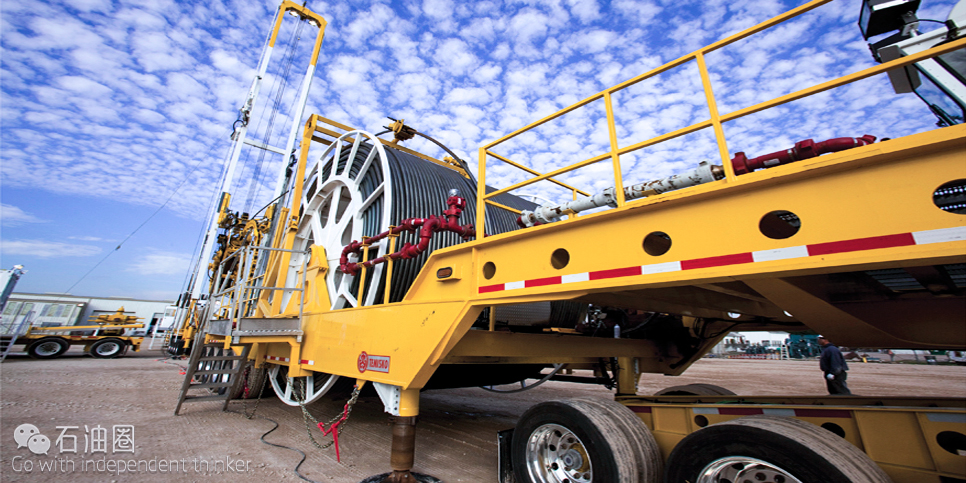CoilCAT—Coiled Tubing Computer-Aided Treatment
Integrated with Schlumberger CT services, the CoilCAT coiled tubing computer-aided treatment is a unique wellsite information management system that takes informed real-time decision making to a high level of confidence. It goes beyond just data acquisition to complete analysis and design, making well intervention operations more efficient and reliable.
The CoilCAT system directly links a PC with the numerous sensors of the CT unit to capture all required parameters. It merges design, execution, and real-time evaluation capabilities, including CoilCADE coiled tubing design and evaluation software, which analyze problems, suggest solutions, and predict the outcome of changing operational parameters within pressure and tension limits.
Users can overlay design and real-time job parameters and redesign them if necessary. Real-time data is available for CT depth, run speed, pipe weight, cumulative volume, and pressure rate. Job monitoring and recording equipment for CT data is available for pipe depth, weight, and running speed; annulus, wellhead, and pump pressure; gripping force; pump rate; and tubing integrity.
A screen generated with the CoilCAT system—The well animation window displays restrictions and the time remaining until the CT BHA reaches the next restriction, allowing the user to be aware of the well profile in real time. The CoilLIFE prediction model window is shown in real time, which enables correct CT life management throughout the entire string and eliminates time-consuming manual calculations of pipe fatigue.
CoilLIMIT limit model envelope—The working limits of CT string pressure and tension are defined, with a green dot moving in real time to show where the limits are within the envelope at any moment.
ADVANTAGES
■ Advanced job preparation
■ Reduced setup time
■ Allows real-time job redesign to account for unexpected conditions
■ Provides visual wellbore and CT string data
■ Tracks key job parameters and connects them to operational alarms
■ Computes, displays, and warns of CT limits
■ Updates string life using CoilLIFE coiled tubing life prediction model
■ Models pressure and tension with CoilLIMIT coiled tubing pressure and tension limit model
■ Generates treatment report on location
■ Zones I and II compliant
■ Can be formatted to ASCII file format
■ Has customizable plots
CoilScan Engineered Pipe Management Service
Determine CT operational limits at the wellsite and prior to CT deployment, and assess pipe integrity throughout the job by detecting CT anomalies.
Continually inspect coiled tubing in real time at the wellsite and before deployment
CoilScan engineered pipe management service provides a comprehensive CT inspection and monitors wall thickness, OD, and length to determine CT operational limits at the wellsite and prior to CT deployment. In addition to monitoring these parameters, the inspection head assesses pipe integrity throughout the job by detecting CT anomalies such as corrosion, pitting, and other types of mechanical damage. Components of the integrated service then generate an inspection report for further analysis.
Monitoring and Managing Coiled Tubing Integrity
Pipe management can now be based on job-to-job, continuous, physical measurements with an object-oriented tracking system that allows CT operators to monitor defects over time with minimal interruption to normal wellsite operations.
CoilScan RT real-time pipe inspection system
The CoilScan RT real-time pipe inspection system ensures pipe reliability with continuous monitoring and tracking of defect evolution throughout the CT string’s service life. The compact system uses magnetic flux leakage (MFL) sensors, eddy current probes, and depth encoders to provide early detection of pipe defects. Due to the CoilScan RT system’s ability to monitor CT in real time, changes to the CT operating envelope can be made on the fly during the job.
CoilScan AP characterization technology
The CoilScan AP characterization technology is a module within CoilCAT coiled tubing computer-aided treatment that identifies and tracks recorded CT defects detected by the CoilScan RT inspection system using MFL signal matching. The technology detects the underlying CT anomaly for the respective MFL response based on a library of documented defects, which consists of actual CT defects with known dimensions.
CoilScan AP system allows consistent, automated in-line real-time inspection assessment, as it does not depend on manual measurement of CT anomaly dimensions.
The CoilScan service provides accurate, noncontact measurements and 3D pipe anomaly visualizations—in real time.
The system minimizes nonproductive time (NPT) by providing real-time pipe inspection during intervention operations to identify CT pipe defects prior to entry into the wellbore.
“Most CT failures in the field can be traced back to some initial defects, such as mechanical damage or a manufacturing defect, resulting in costly NPT and increased exposure to potential health, safety and environmental issues,” said Chaden Lassoued, president, Well Intervention Services, Schlumberger. “The CoilScan system combines real-time dimensional measurements, including wall thickness and diameter, depth measurements and defect detection, to proactively address CT pipe failures.”
The CoilScan system uses real-time pipe dimensions to update the CT fatigue life and the CT working envelope in the manufacturing facility or in the field. The system provides a complete view of what is happening with CT pipe at all times, enabling customers to consider all aspects of pipe management and act accordingly to mitigate failures.
The CoilScan system has been field tested in both onshore and offshore environments, including the United States, Saudi Arabia, the United Arab Emirates, Malaysia and Germany. During field trials, the real-time CT pipe inspection system was used to monitor over 1.5 million running feet (ft) of CT pipe in various environments and applications.
In field trials conducted at an onshore location in North America, the CoilScan system provided inspection results from beginning to end of the CT life. Typical CT strings at this location are used for approximately 500,000 running ft, resulting in an average of 25 to 30 runs. This particular string ran for an additional 200,000 ft, which enabled a total of 40 runs with the CT string. Defects and fatigue areas of the CT string were actively monitored, which provided the customer with the confidence to continue running the pipe longer with a low potential for failure, therefore lowering overall intervention costs.


 石油圈
石油圈


